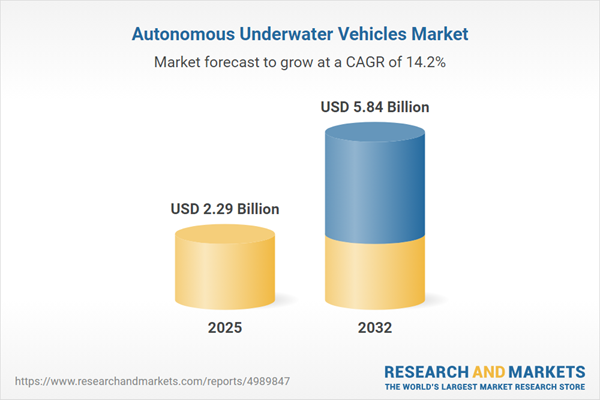Speak directly to the analyst to clarify any post sales queries you may have.
Autonomous Underwater Vehicles (AUVs) are transforming undersea operations, offering organizations enhanced operational flexibility, data accuracy, and strategic insights for marine exploration and defense applications. Senior decision-makers can leverage these advanced platforms to extend their capabilities in monitoring, resource mapping, and mission-critical operations across challenging maritime environments.
Market Snapshot: Autonomous Underwater Vehicles Market Growth and Opportunities
The Autonomous Underwater Vehicles Market grew from USD 2.02 billion in 2024 to USD 2.29 billion in 2025. It is expected to continue growing at a CAGR of 14.18%, reaching USD 5.84 billion by 2032. Rapid expansion is fueled by demand across environmental monitoring, defense operations, and offshore industry activities. This growth signals rising prioritization of subsea autonomy and underscores its strategic value for governments and enterprises managing complex marine assets and operations. The market’s upward trend reflects advancements in artificial intelligence, communications, and sensor integration.
Scope & Segmentation
- Product Types: Large AUVs, Medium AUVs, Shallow AUVs
- Technology Features: Collision Avoidance Systems, Acoustic and Satellite Communication Systems, Imaging Systems such as LED Lighting, Multibeam Echo Sounders, Side-Scan Sonar, Sub-Bottom Profilers, Navigation Technologies including Acoustic, Dead Reckoning, Geophysical, and Inertial Systems, and Propulsion Systems like Battery Modules, Fin Control Actuators, Linear Electromechanical Actuators, Propulsion Motors, Pump Motors
- End Users: Commercial entities in oil and gas, renewable energy, telecommunications, military and defense forces, public sector agencies for disaster management and environmental monitoring, research organizations in government, universities, and independent institutes
- Applications: Archaeology & Exploration, Environmental Protection & Monitoring (encompassing biodiversity, pollution, water quality), Military & Defense (anti-submarine warfare, mine countermeasures, surveillance), Oceanography (including marine studies and research), Oil & Gas (exploration, inspections, maintenance), Search & Salvage Operations (emergency response, recovery missions)
- Key Regions Covered: Americas (United States, Canada, Mexico, Brazil, Argentina, Chile, Colombia, Peru), Europe, Middle East & Africa (United Kingdom, Germany, France, Russia, Italy, Spain, Netherlands, Sweden, Poland, Switzerland, UAE, Saudi Arabia, Qatar, Turkey, Israel, South Africa, Nigeria, Egypt, Kenya), Asia-Pacific (China, India, Japan, Australia, South Korea, Indonesia, Thailand, Malaysia, Singapore, Taiwan)
- Industry Participants: Prominent companies such as Kongsberg Gruppen, Saab AB, Lockheed Martin, General Dynamics Mission Systems, Thales Group, Teledyne Technologies, and others drive innovation and strategic partnerships within the sector
Key Takeaways for Senior Decision-Makers
- Recent advances in artificial intelligence and sensor technology have enabled AUVs to dynamically adapt to complex underwater environments, increasing value for research and defense missions.
- The strategic move toward networked communication and modular vehicle design allows operators to reconfigure platforms quickly, supporting ongoing technological upgrades and diverse mission requirements.
- Emerging partnerships between leading technology firms, research bodies, and defense agencies reinforce rapid development and enhanced operational reliability across global markets.
- Segmentation by vehicle size and application ensures tailored solutions for deep-water exploration, coastal surveys, and near-shore infrastructure inspection, maximizing return on investment for multi-sector stakeholders.
- Increased focus on total cost of ownership and lifecycle management drives organizations to balance new capital expenditures with operational efficiency and long-term sustainability.
Tariff Impact: Adjusting Strategies in Response to U.S. Policy Changes
In 2025, newly enacted U.S. tariffs on critical AUV components have required market participants to revisit supply chain strategies. Manufacturers and integrators are accelerating localization, implementing dual-sourcing policies, and forging domestic alliances to offset tariff-driven cost increases and stabilize production timelines. These adjustments emphasize a growing need for supply chain resilience, driving both strategic diversification and greater cross-border collaboration among solution providers.
Methodology & Data Sources
This analysis is based on thorough secondary research from peer-reviewed literature, regulatory publications, and industry reports, complemented by primary interviews with domain experts in marine engineering and operations. Data triangulation and scenario modeling strengthen the accuracy and reliability of findings, providing a robust basis for strategic recommendations.
Why This Report Matters
- Enables executive decision-makers to assess current technology integration, regional drivers, and regulatory influences impacting procurement and R&D strategies.
- Provides comprehensive segmentation and actionable insights for evaluating growth opportunities, competitive positioning, and emerging industry collaborations.
- Supports supply chain resilience planning through analysis of tariff implications and operational risk mitigation strategies.
Conclusion
The autonomous underwater vehicles market is navigating a phase of rapid transformation, driven by technological advancement, evolving regulatory priorities, and increasing demand for intelligent, resilient undersea solutions. Stakeholders prepared to act on these trends can capitalize on new opportunities in marine operations and subsea innovation.
Additional Product Information:
- Purchase of this report includes 1 year online access with quarterly updates.
- This report can be updated on request. Please contact our Customer Experience team using the Ask a Question widget on our website.
Table of Contents
3. Executive Summary
4. Market Overview
7. Cumulative Impact of Artificial Intelligence 2025
Companies Mentioned
The companies profiled in this Autonomous Underwater Vehicles market report include:- Anduril Industries, Inc.
- ASELSAN A.Ş.
- Boston Engineering Corporation
- Exail SAS
- Fugro N.V.
- General Dynamics Mission Systems, Inc.
- Huntington Ingalls Industries, Inc.
- IHI Corporation
- International Submarine Engineering Ltd.
- Klein Marine Systems, Inc.
- Kongsberg Gruppen ASA
- L3Harris Technologies, Inc.
- Lockheed Martin Corporation
- Naval Group
- Ocean Aero, Inc.
- Oceaneering International, Inc.
- RUAG International Holding Ltd.
- Saab AB
- Teledyne Technologies Incorporated
- Terradepth, Inc.
- Thales Group
- The Boeing Company
Table Information
| Report Attribute | Details |
|---|---|
| No. of Pages | 199 |
| Published | November 2025 |
| Forecast Period | 2025 - 2032 |
| Estimated Market Value ( USD | $ 2.29 Billion |
| Forecasted Market Value ( USD | $ 5.84 Billion |
| Compound Annual Growth Rate | 14.1% |
| Regions Covered | Global |
| No. of Companies Mentioned | 23 |









